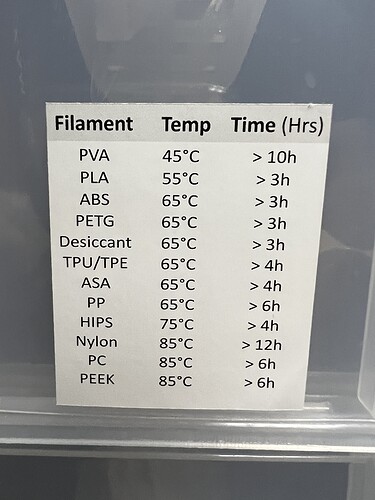I have been using Voxelpla + for a few months now since it was at a good price point relative to the eSun PLA+ that I have not had any problems with. I have been using eSun PLA+ for many years now.
Recently I have I noticed that if I leave a spool of voxelpla on my printer for more than a day or two at the most, the filament will break which leads me to believe this is more hygroscopic than the eSun PLA + I use. I very seldom had that filament break on me and never after only 1 or 2 days being left out. I do not use a filament dryer but have recently been thinking about buying one. It is a little annoying to have to put my filament back in a bag with desiccant if I am not going to print for a day. I store all my filaments in separate big zip lock bags with desicant when they are not loaded on my printer. I also print the voxelpla + at 215c which is about 5 degrees hotter than I normally did with the eSun PLA+
Comparing the datasheet of the Voxelpla + to eSun PLA+, looks like it probably has more tpu in it since it seems more flexible than eSun PLA+. Here are links to the datasheets on both for comparison in case someone with more knowledge of this would like to pipe in on the differences.
PLA+ (pro) Technical Data Sheet (shopify.com)
I found 2 links to the eSun PLA+ that are slightly different. I would think the datasheet from eSun would be the most current.
PLA+ (esun3d.com)
https://www.matterhackers.com/r/oqRtJt
which according to ChatGPT tpu is more hygroscopic that pla.
From ChatGPT
"Yes, TPU (Thermoplastic Polyurethane) filament is generally more hygroscopic than PLA (Polylactic Acid) filament. Hygroscopicity refers to a material’s ability to absorb moisture from the surrounding environment.
TPU is known to have higher water absorption properties compared to PLA. It can absorb moisture from the air, which can affect the print quality and performance of TPU filaments. When TPU absorbs moisture, it may lead to issues like filament swelling, decreased print quality, and increased brittleness.
On the other hand, PLA is considered to be less hygroscopic than TPU. PLA filaments have lower water absorption properties, and therefore they are generally less affected by moisture in the air. However, it is still recommended to store PLA filaments in a dry environment to maintain their optimal printing conditions.
To mitigate the hygroscopic effects of TPU and PLA filaments, it is advisable to store them in airtight containers or vacuum-sealed bags along with desiccant packs, which help absorb moisture and preserve the filament’s quality."
ChatGPT works pretty good for giving simple English for the comparisons of this data.
VoxelPLA+ from datasheet is 74 for the Flexural strength & eSun PLA+ is 95.
“Which flexes more, Flexural Strength of 74 or 95”
"Flexural strength is a measure of a material’s ability to resist deformation under bending forces. It indicates the maximum stress that a material can withstand before it bends or breaks.
In the context of comparing flexural strengths of 74 and 95, a higher flexural strength value of 95 indicates that the material is more resistant to bending and deformation compared to a value of 74. A material with a higher flexural strength can withstand higher bending forces without experiencing permanent deformation or failure.
Therefore, in terms of flexing more, a material with a flexural strength of 95 would be stronger and less prone to bending or deformation compared to a material with a flexural strength of 74."
